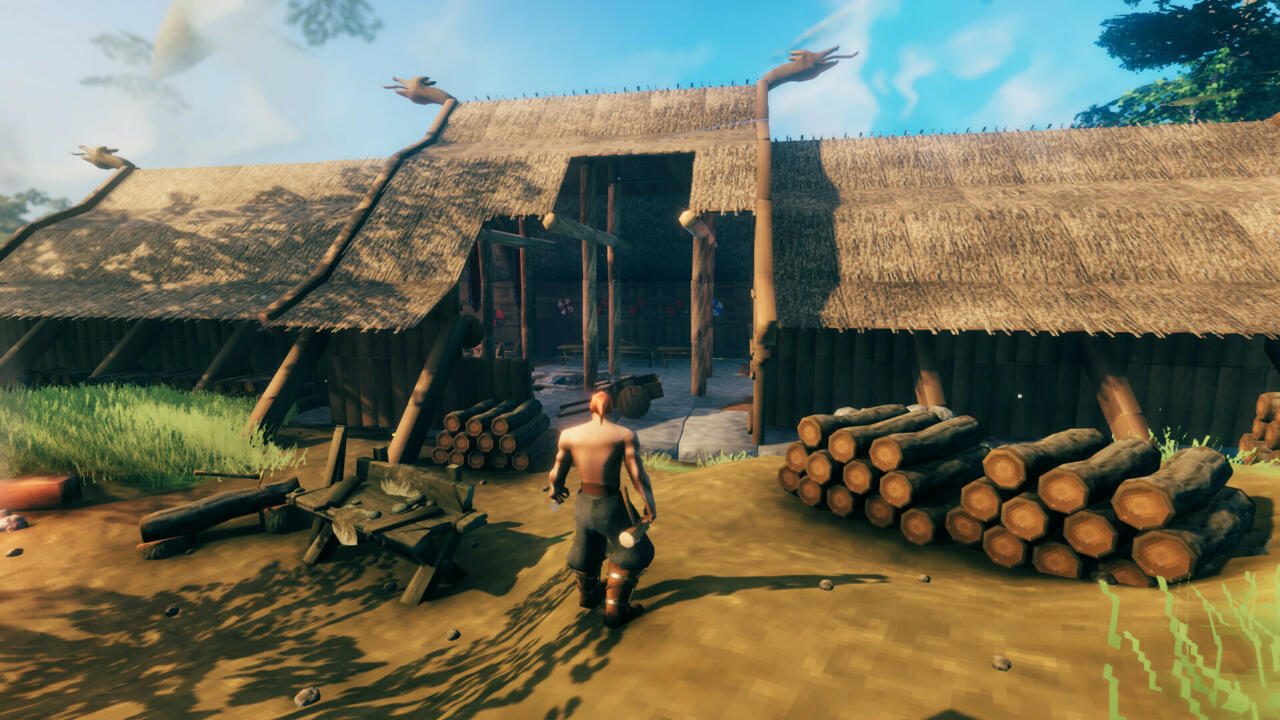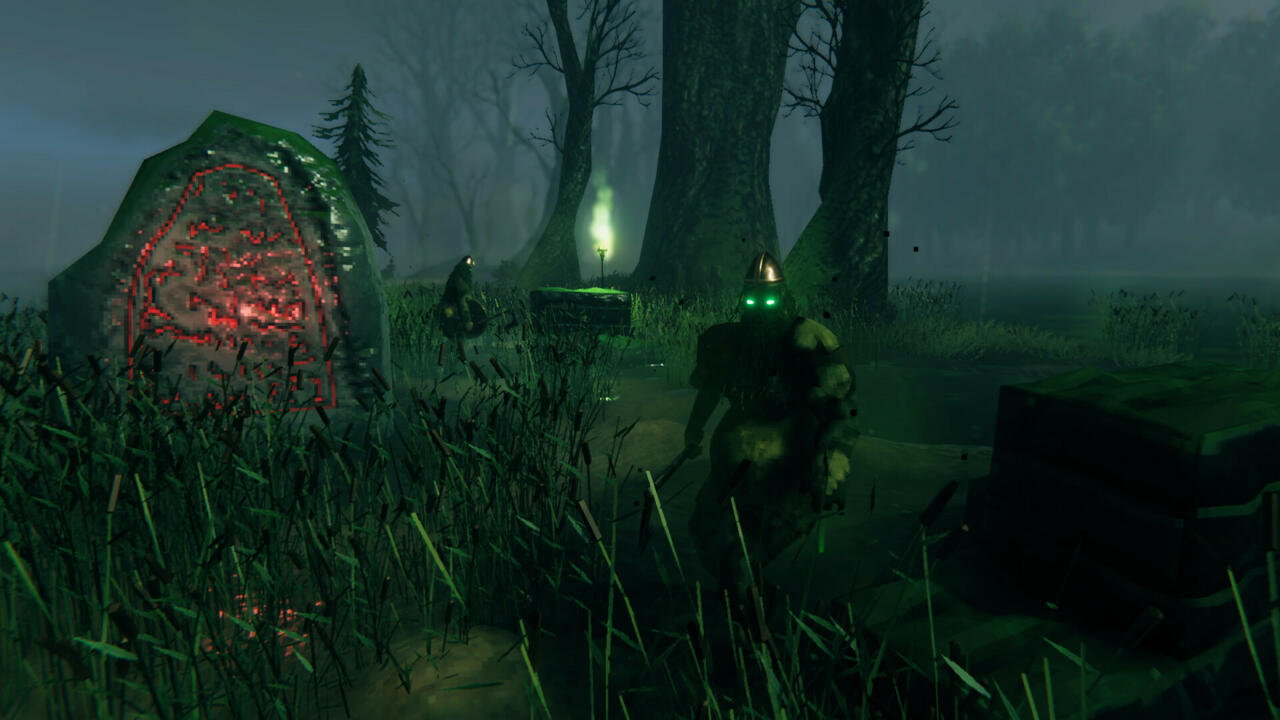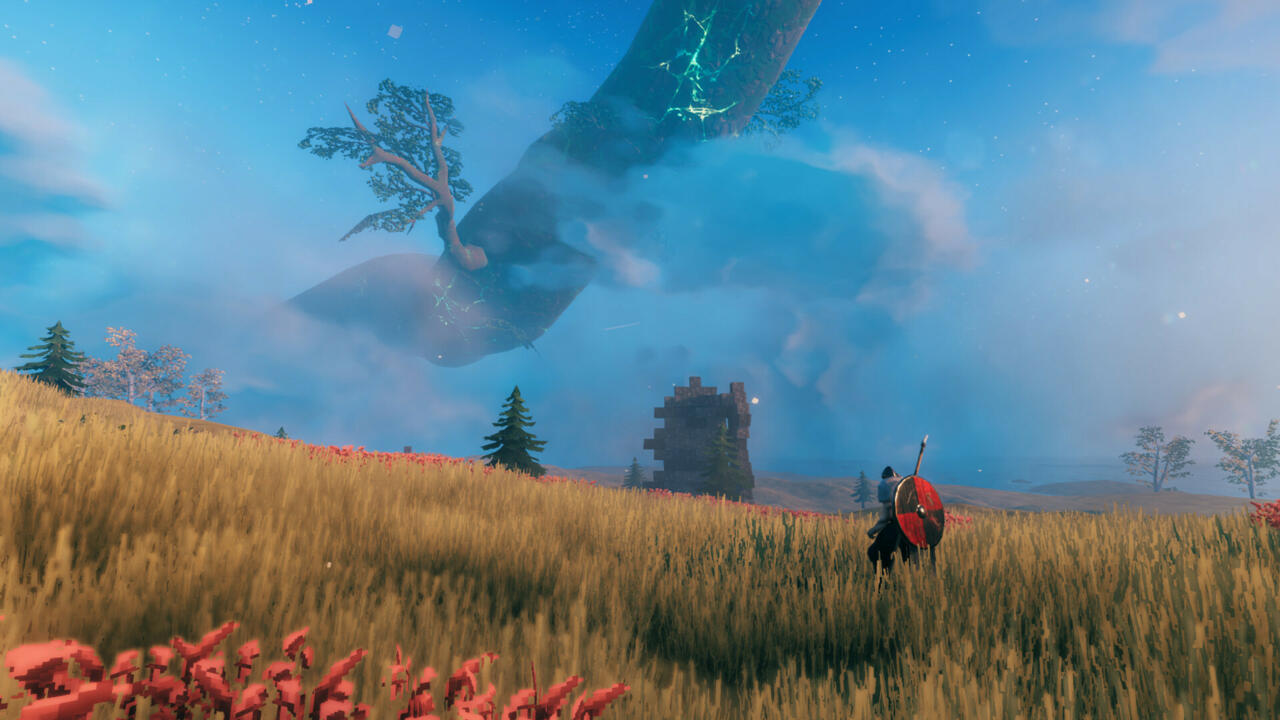Valheim's record-breaking success isn't too surprising, even if you ignore outside elements like the current global pandemic and the game's relatively low price point. There's an obvious appetite for survival games on PC, as evidenced by the likes of Rust and Ark: Survival Evolved consistently butting heads on Steam's most-played list. Yet Valheim also appeals to people like me, who aren't particularly fond of the genre. There are a number of reasons for this, but chief among them is the fact that Valheim plays down all of the restrictive survival aspects that form the foundations of similar games.
The first structure my friends and I built in Valheim has now become known as our home base. In keeping with the game's viking theme, it's vaguely reminiscent of a Norse longhouse, complete with mead and a dining table. Colourful banners and trophies of the monsters we've slain adorn its wooden walls, and the outside courtyard features a smelter for refining precious ores and a kiln for producing the coal that powers it. Each person has their own bedroom with a place to sleep and chests to store their valuables, and there are also communal chests for everyone to contribute various resources like food, wood, and stone. Meanwhile, the house's defenses consist of a spiked fence encircling the entire property and an improvised moat that's proven surprisingly effective at keeping monsters at bay.
Can anyone argue that constructing our forever home would've been a better experience if we also had to worry about thirst and hunger meters while doing so? This has always been my main sticking point with most other survival games, and Valheim removes this prohibitive aspect completely. Food is still a factor, but you're not going to keel over and die if you haven't eaten for a few in-game hours. Instead, food provides you with health rather than acting as a ticking clock. You can eat up to three food items at any one time, and the combination of which will determine the size of your health bar and the speed at which it regenerates. My diet currently consists of cooked fish, sausages, and a slab of deer meat, but food sources are plentiful, with berries, mushrooms, and other meat-based treats all available to gather and consume.

If you're simply building structures you don't even need to engage with this system. Eating is something you do before exploring potentially dangerous areas, so in some ways the mechanic is more like Breath of the Wild than any other survival game. Speaking of which, weapon durability exists, too, but even this is largely hassle-free in Valheim. Tools and weapons will break through usage, but this is a non-issue unless you're in the midst of a battle. As long as you have a workbench handy you can fix your equipment without using any resources. The same is true of your buildings as well. They can degrade over time, and enemies have a habit of hitting any structures they find, but as long as there's a workbench in the vicinity you can simply repair walls and furniture so that they're good as new.
You're never required to gather crafting resources in order to fix what you're already got, only to build brand-new equipment or upgrade what you currently have. This creates a satisfying loop where exploration often concludes with the option to expand your arsenal, whether that means crafting a new sword, piece of armor, or crafting station.
Eating, drinking, repairing structures, and fixing or replacing tools are little more than daily busywork in most other survival games. They're often dull and tedious distractions as opposed to engaging mechanics, and Valheim doesn't lose anything by disregarding them. It's a better and more approachable game for it, where the emphasis and challenge come from embarking on risky expeditions and overcoming obstacles with friends, rather than ensuring you have enough sustenance to survive the day. Valheim focuses on the genre's most attractive traits instead of trying to replicate a survival experience that only serves to add artificial difficulty and detract from your anecdote-worthy adventures into the unknown.

This is where Valheim introduces some of its own strengths rather than simply removing the genre's weaknesses. The frankly gargantuan map is currently made up of six varied biomes, each with its own aesthetic, resources, and enemy types. It's all procedurally generated, too, so no two game worlds are exactly the same. You can venture into any of the biomes right from the game's outset, but you're probably going to need a boat to reach some of them. Doing so isn't the wisest of decisions, however, since Valheim gates your progress by ramping up the enemy difficulty in each successive biome. To aid your advancement through its world, a general path has been laid out in the form of a boss run of sorts.
The first boss, Eikthyr, is a large stag that presides over the Meadows biome. Defeating it rewards you with its powerful antlers, which can then be used to craft the antler pickaxe. This is a key tool in the next biome, as the pickaxe allows you to gather the copper and tin located there. These are the ingredients you need to craft bronze, thereby allowing you to forge stronger armor, weapons, and other tools.
Valheim focuses on the genre's most attractive traits instead of trying to replicate a survival experience that only serves to add artificial difficulty and detract from your anecdote-worthy adventures into the unknown.
Valheim's core gameplay loop revolves around this routine, whereby defeating a boss will reward you with an item that aids your progression into the next biome. It's slightly more involved than this, of course, especially when it comes to discovering where each boss is located and figuring out the best way to defeat them. The second boss, Elder, is pretty self-explanatory in this regard, being that it's a giant tree and wood doesn't mesh well with fire. Bonemass' weaknesses, on the other hand, aren't quite as intuitive and require some experimentation if you're going to vanquish the third boss. Fortunately, the penalty for dying isn't too harsh. You still lose everything in your inventory when you perish, but as long as you can return to where you died, you can retrieve it all. This becomes a larger issue when you're miles and miles away from where you call home, but that's what teleports are for. If you have the required materials to make one, teleports give you an easy way to traverse large swaths of the map in an instant.

Preparing for a boss fight might actually be one of my favourite parts of Valheim. Upon discovering that Bonemass is weak to a specific damage type, we went to work gathering the iron needed to craft a weapon for everyone that would deal the requisite pain. This was an ordeal in itself as we had to venture into sunken crypts and fight through skeletons and draugrs in order to mine the amount of iron we required. While this was happening, we were also fermenting poison-resistant potions for everybody and gathering a lot of food to ensure everyone's health was topped up. I was on fishing duty, while others hunted deer and used the cauldron to create unique meals. Once we felt suitably prepared, we tucked into bed for a good night's sleep and then marched on the boss with Yggdrasil's sacred branches looming above us.
Once you are face to face with an enemy, Valheim's combat is decent if unspectacular. Weapons are diverse and attack differently depending on which type you're using, and both parries and critical hits are met with an inherently satisfying sound cue that coincides with the enemy being sent staggering backwards. Stealth is an option as well, especially when combined with a bow, and Valheim adopts the Elder Scrolls method of leveling up, as different stats improve through use. If you're using maces a lot, your skill with maces will improve, while the same rings true for physical activities like running, swimming, and chopping wood.

Beyond the boss fights and character progression, Valheim also succeeds in enticing you to explore its vast open world. This is partly due to its surprisingly beautiful visuals, as it adopts a deliberately lo-fi aesthetic that's reminiscent of early 3D games. Pixelated and low-poly models are elevated by modern techniques such as realistic lighting, particle effects, and depth of field, and screenshots fail to adequately do it justice, especially when it comes to the ambience present in each forested hillside and snow-capped mountain top. This environmental variety is part of what makes exploring Valheim's world such a joy, too. The procedural generation is particularly impressive, presenting cohesive and natural environments that feel like they were handmade.
The world of Valheim is already a wonderful one to inhabit, and I can't wait to see where it goes from here.
There are a few issues to speak of, including finicky building controls that arise when trying to connect pre-made building pieces in third-person. With that said, the pre-made pieces don't stunt creativity at least, with plenty of examples of people constructing some frankly outlandish creations. The fact you can't dismantle items is another inconvenience, since unwanted tools and weapons either end up polluting the landscape or filling up chests. The forging and fermenting process is also exceedingly slow, and there are a few instances where it can be overly grindy. Valheim's grind isn't bad in and of itself, but there are a few moments in the latter biomes where it can devolve into tedium. Crafting the Mountain biome's unique helmet, for example, requires two Drake trophies to build. Drakes are fairly plentiful, but the drop rate for their trophies is only 15%, which means you're likely to spend hours hunting the flying menaces in the hope two of them drop what you need. Normally you have a degree of control over Valheim's grind, yet this is a stark example where you're at the whim of the RNG.
Most of these are minor complaints in truth, and each one is an aspect that will hopefully be rectified and re-balanced in the coming weeks and months. Even as an Early Access title, Valheim is more fleshed-out than many finished games, and it's going to be exciting to see how it evolves over the next year as systems are improved and more content is added. The world of Valheim is already a wonderful one to inhabit, and I can't wait to see where it goes from here.

